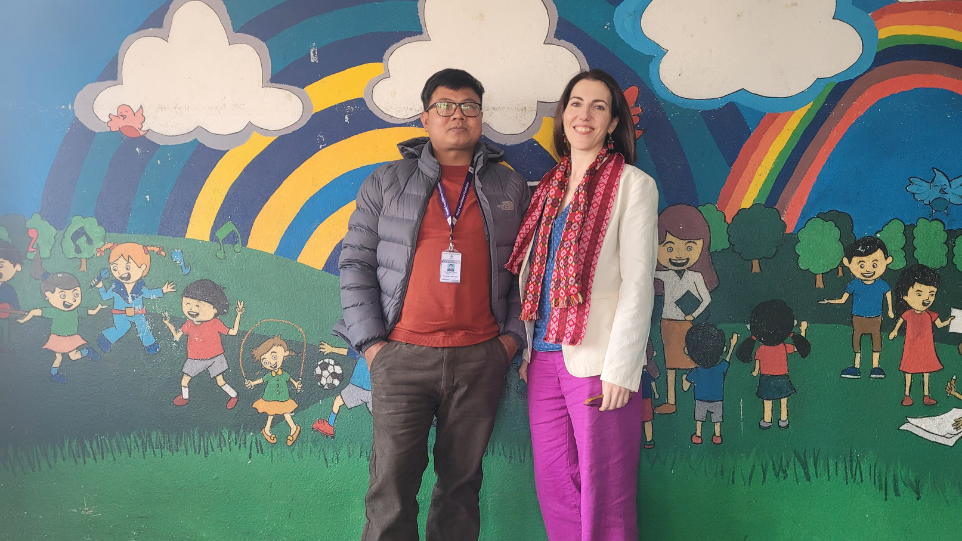Healing and hope for child labor survivors in Nepal
April 15, 2024Written by Silvia Mera.
It is a sunny early afternoon in Kathmandu, Nepal. The streets, though not bustling, hum with the occasional passing motorbike and the cheerful laughter of children walking hand in hand with their mothers. As I ascend the stairs to the top floor of “Hamro Ghar” – the home for child labor survivors managed by the Nepal GoodWeave Foundation – a sense of hope fills the air.

The spacious entryway, adorned with vibrant murals, opens into three classrooms where children are sitting at their desks and busy with their textbooks. All of them were previously working in carpet factories instead of attending school and were identified by GoodWeave inspectors during worksite inspections. For these children, Hamro Ghar, meaning “our home” in Nepali, isn’t just a shelter; it’s a lifeline — a safe haven where they can begin their journey toward healing and education.
In one of the classrooms, I recognize Binuka, whose story I had heard from my colleague and Child Development program lead, Hem Moktan. Orphaned since the age of ten, and originally from Makwanpur district, some 100 km from Kathmandu, Binuka was kept in domestic servitude and verbally abused at her brother’s house before being trafficked to work in a carpet factory in Kathmandu. There, she barely received a salary, and experienced even more mistreatment. After three years, she was identified by a GoodWeave inspector, removed from the factory and brought to Hamro Ghar.

Every year, millions of children worldwide are subjected to child labor, robbed of their innocence and deprived of their basic rights. An estimated 160 million children are engaged in child labor globally, with a significant portion involved in hazardous work. In Nepal, 1.1 million children are exploited in sectors including agriculture, domestic work, brick making and textile manufacturing. GoodWeave inspectors continue to identify child labor cases in the Nepali carpet sector, most of them in hidden, outsourced, and informal worksites.
With increasing cases of child labor, long-term, child-centric remediation options are more vital than ever – and increasingly need funding.
A recent peer-reviewed article published in the prestigious Journal of Modern Slavery, highlighted the important work Hamro Ghar is doing to rehabilitate child laborers. The article, which I authored with Hem Moktan, Nepal GoodWeave Foundation’s Child Development Officer, describes how the programs implemented at Hamro Ghar are aligned with the principles of the best interest of the child, and how this approach addresses the complex needs of child labor survivors and provides them with long-term rehabilitation and reintegration into mainstream school.

Remedy indicates the process of restoring rights to survivors and provide near-term medical, psychological, social, legal and educational assistance. It is an essential element of corporate accountability. However, globally, only a very small share of those subjected to forced labor are provided with some form of remedy. Reasons includes companies often taking a “zero-tolerance” approach, cutting business relationships with suppliers when human right abuse are identified, using “for-hire” firms that are not able to navigate local contexts and provide tailored services, and focusing on short-term fixes that do not take into account that rehabilitation from human rights abuse is often a multi-year, multi-faceted journey.
Binuka smiles at me as I enter the classroom and introduce myself. She shares a few words, expressing her dream to become a teacher – but her eyes remain sad.
Hem tells me she is doing well and catching up with her studies. However, the road to full rehabilitation is not easy. Hem knows this firsthand; he was in the same shoes as Binuka years ago. He was trafficked to a carpet factory at age ten and endured years of beatings and verbal abuse before being removed from the factory and brought to Hamro Ghar. Fast forward twenty years, and he now leads the rehabilitation programs at the Foundation. A film capturing his inspiring story was recently selected and screened during the United Nations’ Forum on Business and Human Rights – the largest global conference on the topic.
Remediation can only be effective if implemented through collaborative efforts between sourcing companies and suppliers, and involve an appropriately qualified, local civil society organization. Programs that meaningfully engage survivors, are children-centric and designed for long-term support have the best chance to rehabilitate children who have experienced the trauma of harsh labor. At Hamro Ghar, children are counselled and supported to regain confidence, and given an opportunity to attend school and participate in extra-curricular activities in a safe environment. Upon graduation, they can secure a spot at a prestigious secondary school in the city, with tuition fees paid through the end of their studies.
More children need support, and we urge you to join us in this mission. We recently launched a dedicated project to raise funds for Hamro Ghar, providing children like Binuka with access to essential resources and support on their journey from exploitation to education and empowerment.
